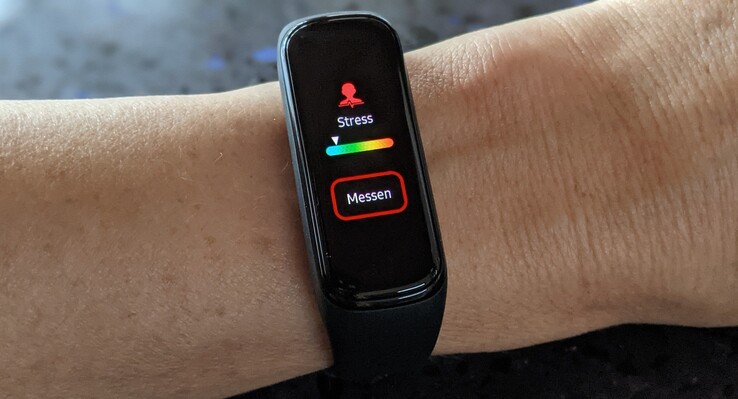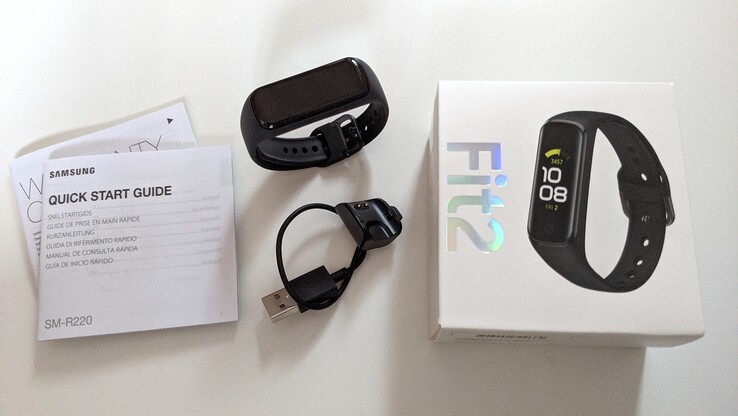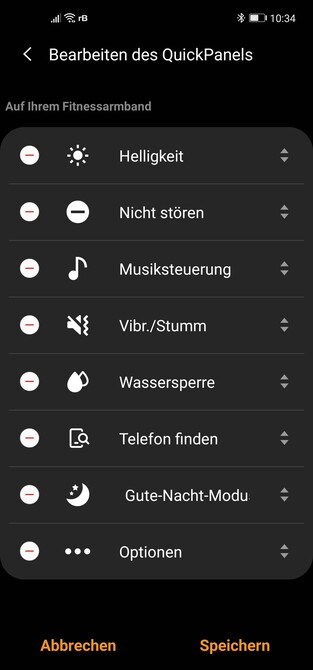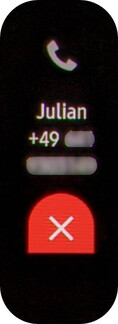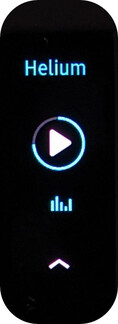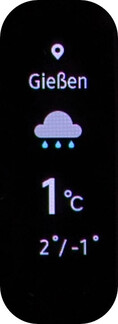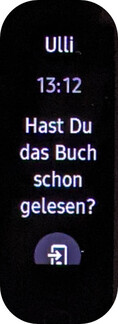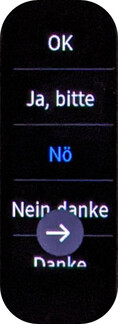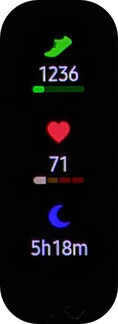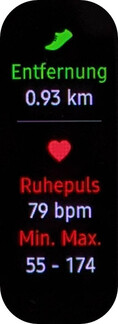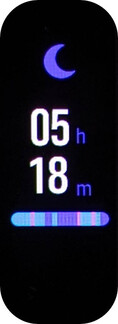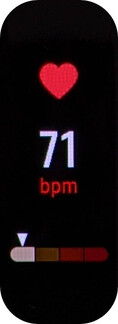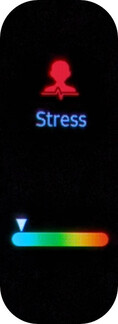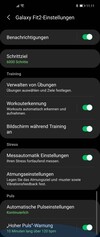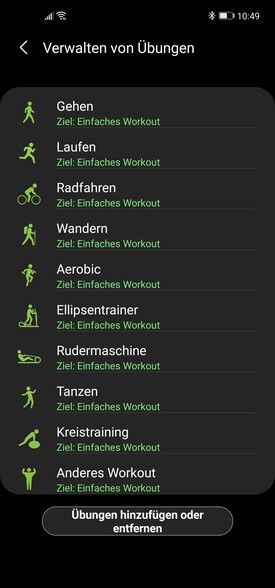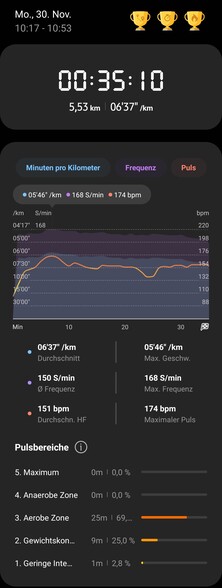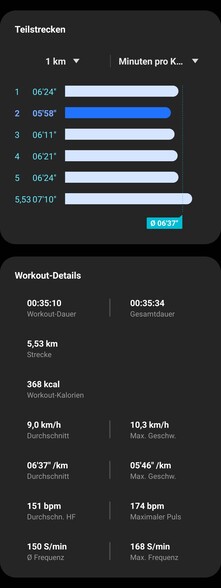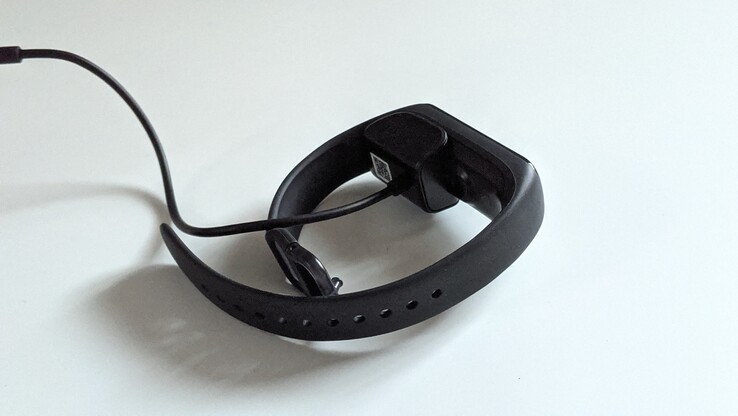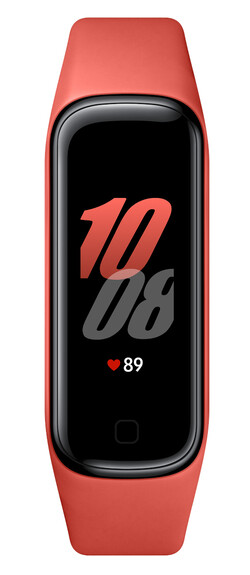Samsung Galaxy Fit2 fitness tracker in the review: Better than its predecessor and significantly cheaper.
Case and equipment - Galaxy Fit 2 without brightness sensor
Visually, the Galaxy Fit2 is largely the same as the 2019 model. Samsung has improved several points: The battery now comes to 159 mAh instead of 120 mAh; the AMOLED color display has grown from 0.95 to 1.1 inch, the resolution from 120 x 240 pixels to now 126 x 294 pixels.
Still missing is an automatic brightness control. In the test, a medium brightness was sufficient in most cases to make the display easy to read, even outdoors. Samsung integrated a sensor button below the visible screen.
The internal memory is only 32 MB. That's not much by today's standards, but it's enough to store the data for a few days. In the test, we disconnected the connection for three days and synchronized on the fourth with no problems.
At 24 g (~0.85 oz) Fit2 is lightweight, IP68 certified and can withstand water pressure up to 5 ATM. In addition to position and acceleration sensors, the Galaxy Fit2 has a pulse sensor that can record the heart rate all day if desired. It does not measure blood oxygen saturation, and there is no NFC for Samsung Pay and GPS. Samsung does not provide any information on assisted GPS (A-GPS); however, the Galaxy Fit2 confirms a GPS signal in the test when it is connected to the smartphone during a workout.
Setup and operation
First, download the app Galaxy Wearable, which is also available for iOS from the App Store. We have tested with an Android smartphone. There, Galaxy Wearable downloads a plug-in for InEars, Smartwatches and Tracker, in this case the Galaxy Fit2-Plugin.
On the smartphone, you select the dial and arrange the widgets, among other things, to which you can access with horizontal swiping gestures. You can hide those you don't need. A vertical gesture from top-to-bottom opens a quick panel, which you can use to regulate the brightness and activate the no-disturbance mode, among other things.
The sensor button below the visible screen has not been highlighted by Samsung. It leads back to the dial and activates the display when, for example, your hand is on the keyboard and you want to read the time. Alternatively, the display activates when you raise your arm. The option that the display always stays on is not yet available for the Galaxy Fit2.
Incoming messages from social networks can be answered with ready-made texts, and incoming phone calls can be rejected. In addition to widgets for timer, stopwatch and weather information, there is a music widget. It always controls the music app that is currently active on the smartphone; this can be the smartphone's integrated music player, but also Deezer or Spotify
Health tracking with Samsung Health
Samsung manages health tracking, sports and fitness functions via its Health app. A user account is optional. Samsung presents the data well and displays it in clear diagrams. Less nice are permanently changing advertising images, which have been filling the upper part of the day view for some time now.
In the Health App you set a target for the number of steps you want to take each day and can activate automatic motion detection for sports such as running and cycling. If you decide to measure your heart rate continuously - alternatives are manual or interval measurement - the fitness tracker can issue a warning if your heart rate exceeds a predefined limit for more than 10 minutes.
In the day view, the health app shows fields like the one for blood oxygen saturation (SpO2), which a Galaxy Watch 3 fills, but not Samsung's fitness tracker. If you do not maintain them manually, you can hide these fields. If you wear the tracker also at night, Health shows a sleep log and the history of the past days. Some of the data is displayed by the fitness tracker in compressed form via the widgets.
Sports - Strong even without GPS
Samsung supports numerous sports modes. Ten of them can be transferred to the fitness band, and you can decide whether the display should remain permanently on during the workout. The Galaxy Fit2 does not have its own GPS. There is no reference in these specifications to the use of the smartphone GPS (A-GPS). Nevertheless, it signals its use with a green GPS icon when it is connected; however, the training record does not provide a route record.
For our test, three runs were made using the Galaxy Fit2. In the first one, the smartphone was also included, but the logged distance deviated significantly from the distance actually run. Possibly the Bluetooth connection broke down in between. In two further runs, the smartphone remained on the desk. In this case, Samsung deduces the stride length from the body height, if it is stored in Health; in combination with the sensor data, an estimate of the distance covered is possible, which was surprisingly successful in the test: In the second run, the determined distance deviated by about 300 m (~328 yards) from the actual one (about 5 km/3.1 miles), in the one before only 50 m (~55 yards). Whether the algorithm always works this well depends on several factors and cannot be said with certainty.
For a swimming training simulated in the test, the situation is different: In a dry run, the Galaxy Fit2 counted both the number of swim strokes correctly and the lanes indicated by changes in direction. If it is necessary to leave the smartphone in the locker, the length of the lanes (25 m/~27 yards by default) should be changed before entering the pool hall, because this is not possible on the tracker itself.
The tracker did not always recognize the simulated swimming style correctly, which may have been due to the execution. It's a pity, however, that if Samsung misinterprets the swimming style, it is not possible to correct it in the log.
During the workout with the rowing machine, Samsung did not foresee counting the moves until the end of the test, although the sensors could certainly detect them.
Battery life
The 159 mAh battery lasts up to 21 days according to Samsung. Our recording at run time reflects a practice scenario with three half-hour workouts (display switched on) and permanent pulse measurement, because the Galaxy Fit2 gives out a warning only in this setting. Intermediate projections resulted in a runtime of about eight and a half days, in the end it was exactly 9 days. With a remaining capacity of 20%, the fitness band responds by vibrating and at less than 5%, reduces the display brightness to the minimum (level 1).
Verdict
In the category of simple fitness bands, which includes Samsung's Galaxy Fit2, 50 Euros (~$61) is still a lot. The RRP for the similarly equipped Xiaomi Mi Band 5 is 39 Euros (~$47, the market price approximately 34 Euros/~$41). But if you look at the two displays in a direct comparison, the very good readability of the sharper Galaxy display explains the additional price.
50 Euros (~$61) is still a lot for a functionally simple fitness tracker. Samsung justifies it with quality.
Gaps such as GPS, NFC or SpO2 sensor are filled by trackers whose RRP is slightly higher than Samsung's. Thanks to sinking market prices, however, the Huawei Band 4 Pro with GPS and SpO2 measurement, for example, is recommended. A further alternative is Honor Band 5, which is to be had in the meantime for under 40 Euros (~$48). But the price of the Samsung Tracker sank in the meantime. At the end of the test the market price lay scarcely over 40 Euros (~$48).




